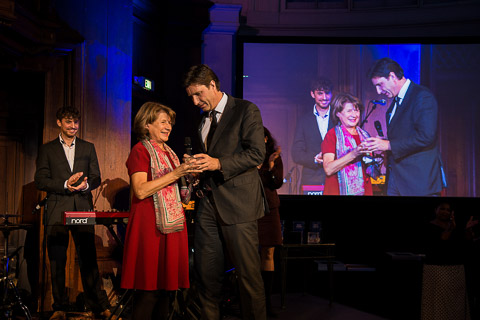FIAT/IFTA Workshop on Preserving Africa’s Audiovisual Heritage

Students from the MA programme Preservation and Presentation of the Moving Image participated in the 2014 World Conference of FIAT/IFTA. They share their impressions in a series of blog reports. Lenka Suchá wrote this report.
After a series of presentations and discussions on archives operating in a predominantly European context, Friday morning’s session promised to offer an alternative perspective by introducing a preservation project based in French-speaking Africa.
The Organisation Internationale de la Francophonie launched the Digital Investment Project in order to rescue the incredible wealth of Africa’s cultural heritage. African archives are endangered by a lack of resources, expertise and relevant legislation.
Representing key partner organisations, Pierre Barrot (OIF), Clément Malherbe (INA) and Maxime Sanson (INA) introduced the aims and technological solutions underlying the project. Its most unique and complex aspect is the plan to create a regional legal deposit for radio, TV and cinema.
In order to harmonise and incorporate the laws of the 8 participating countries, experts have been working in the region to collect information and existing legislation. Further contributions include skills training, digitsation and the provision of a new version of the indexation programme AIME (Archivage Interactif Multimédia Evolutif), which promises a user-friendlier interface and a straightforward exchange of programmes between countries via the web app Archibald.
Achabi Saratou Amoussa Kabirou of ORTN (Niger) expressed her satisfaction with the new version of AIME and its contribution to a more straightforward archiving process. The ORTN archive has been able to digitise 12,000 hours of material by now, and the process is on-going.
Tsilavina Ralaindimby from Madagascar’s Fl@h project presented the most promising case. Their awareness-raising activities are aimed at the general public so that they learn to appreciate the importance of archives and audiovisual memory as their own heritage. The archive is also encouraging young producers (for example the musician and film-maker Mota) to use archival footage in their works. Fl@h’s biggest challenge lies in the fact that they are an independent body and thus receive no public funding – instead, they have to be creative in their quest for finding revenue.
Hamet Ba of Senegal’s RTS sees the greatest advantage of the project in re-organising the system and bringing archives together under the same legislation, giving them the tools to preserve their own heritage. There is a lack of infrastructure and personnel in African audiovisual archives, and if there are laws governing them, they are most likely taken over from French law. Mr Ba highlighted his previous experience of collaborating with FIAT/IFTA and OIF as one of the reasons why both sides were aware of the situation and the urgent need of taking action.
RTB’s Bourema Yoda (Burkina Faso) appreciated the recent improvement in the situation but stressed that a lot remains to be done, as there are 50 years’ worth of material awaiting urgent digitisation. One of the obstacles to digitisation in the case of RTB is their inability to access footage due to a lack of available technology or working equipment. He identified a source of revenue by approaching companies (e.g. mining or transport) as everyone has an image to uphold, making it their best interest to contribute to the preservation of regional heritage.
A brief rundown of the project in the context of Mali’s ORTM was presented by Diarra Bakary. The archive exists as part of the public service broadcaster and their main needs are a lack of training and malfunctioning or out-dated equipment that FIAT/IFTA is helping them with.
The session left something to be desired. The individual archives’ presentations did not have time to go in-depth and a more detailed picture of individual implementations of the project would have been helpful. The allocation of time was imbalanced and the presentation of the overarching project took up longer than expected, thus the remainder of the session felt a bit rushed. Tsilavina Ralaindimby and Fl@h were by far the best-presented case. During the Q&A, a member of the audience suggested that the archives needed to be more explicit in describing their specific problems and showcasing their requests, projects and successes to help with the financing in the future. But it is a vicious circle – governments often question the benefits of these projects and a lot of lobbying is required to get anything off the ground. With a lack of support on the home front, it can be problematic to have anything to show. As Mr. Yoda observed, there is a lot at stake and many challenges lie ahead. The situation in West Africa is very different to the one in Amsterdam and although there is progress, those involved must keep up their effort. At the very least, there is hope.
 FIAT/IFTA Award winners on stage during the awards dinner. Photo credit: Oscar Timmers.
FIAT/IFTA Award winners on stage during the awards dinner. Photo credit: Oscar Timmers.
More info
- See more photos, presentations and papers over at the FIAT/IFTA website.
